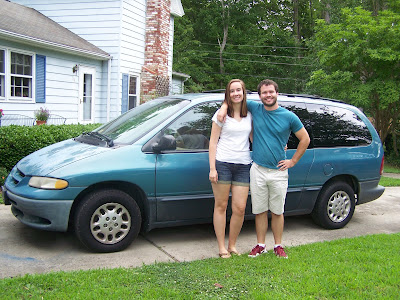On one of our three days in Moab, we drove out to Canyonlands National Park. The park has two main areas; we visited the Island in the Sky district while staying in Moab. This area is a large mesa top that overlooks both the Colorado and Green Rivers on either side and the stunning canyons the rivers have cut. For a lesser-known national park, I was surprised at how scenic and enjoyable it was!
One hike we did was to Upheaval Dome, a 2-mile diameter crater in the park. Geologists say they can't figure out why it's there. It's pretty strange, filled with piles of mystery grey-colored sediments but surrounded by red sandstone.
We left Moab on Friday after our windy, sandy three-day stay. We didn't get out before the weather gave one more blow: light rain our last night there meant that the tent and its contents were not only sandy, but wet. It was a mess, but fortunately the inside of the tent (and the contents) remained mostly dry. We repacked the car and headed out to the other half of Canyonlands NP: The Needles district. This part of the park is remote, less visited, and known for a range of rock spires that looks like a field of needles.
Our first task was to find a campsite, which proved to be one of the strangest encounters we've yet had on the trip. The campground in the park was full, so we went to the private campground just outside the park. Here, we looked around at the spots to pick a sunny one to dry out the tent and equipment: this was our cardinal sin. When we headed in the store to register with a spot in mind, the woman owner instantly jumped us, asking "if we could read" and telling us that we were supposed to register before looking around. Despite my explanation, she could have cared less and said she had "no interest in people like you" and that we were "welcome to camp up the road somewhere else."
We left (sort of stunned) and drove a few miles back down the one road to the park to explore the BLM lands for camping spots. However, all of the roads were impassable for the van, especially after the recent rains in the area. There were no other camping options, and we had no choice but to make our visit to the park quick and just keep heading down the road afterwards. We checked out the visitors center, drove through the park, and walked two short hikes to a canyon and a strange pothole-covered rock.
 |
| Looking across Canyonlands |
We left and found a National Forest campground just outside of Monticello, UT. We arrived late in the afternoon but still in time to unpack the tent and tarps with the hope that they would dry out. Because of their condition, we would have to sleep cramped in the car. Another reason to sleep in the car was the record lows forecast for that night of around 30 degrees. Despite our positive hopes leaving Moab that morning, we found ourselves once again sleeping in the car to avoid the cold, windy weather.
 |
| Our poor tent before cleaning and drying out |
 |
| Cooking in the car for the fourth (or something?) day |
We woke up on Saturday morning to a temperature of 27 degrees and frost on the inside of the car windows. We packed up the tent as quickly as possible. It was much cleaner, though it was covered in frost that would inevitably melt in the car. Even though the night had been cold and planned last-minute, we made it, and we set out for Colorado around 7:30 AM. Only two nights of camping were left while heading southeast and down in elevation to our sprint east and home, which left us with hope that things would only go uphill.
After so long on the road and the recent tough weather, we're in New Mexico now with a week left. I'm hopeful and excited to finish so soon: surely we can survive whatever is left!











































